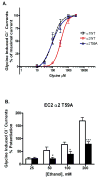Targets for ethanol action and antagonism in loop 2 of the extracellular domain of glycine receptors
- PMID: 18485105
- PMCID: PMC4409138
- DOI: 10.1111/j.1471-4159.2008.05476.x
Targets for ethanol action and antagonism in loop 2 of the extracellular domain of glycine receptors
Abstract
The present studies used increased atmospheric pressure in place of a traditional pharmacological antagonist to probe the molecular sites and mechanisms of ethanol action in glycine receptors (GlyRs). Based on previous studies, we tested the hypothesis that physical-chemical properties at position 52 in extracellular domain Loop 2 of alpha1GlyRs, or the homologous alpha2GlyR position 59, determine sensitivity to ethanol and pressure antagonism of ethanol. Pressure antagonized ethanol in alpha1GlyRs that contain a non-polar residue at position 52, but did not antagonize ethanol in receptors with a polar residue at this position. Ethanol sensitivity in receptors with polar substitutions at position 52 was significantly lower than GlyRs with non-polar residues at this position. The alpha2T59A mutation switched sensitivity to ethanol and pressure antagonism in the WTalpha2GlyR, thereby making it alpha1-like. Collectively, these findings indicate that (i) polarity at position 52 plays a key role in determining sensitivity to ethanol and pressure antagonism of ethanol; (ii) the extracellular domain in alpha1- and alpha2GlyRs is a target for ethanol action and antagonism and (iii) there is structural-functional homology across subunits in Loop 2 of GlyRs with respect to their roles in determining sensitivity to ethanol and pressure antagonism of ethanol. These findings should help in the development of pharmacological agents that antagonize ethanol.
Figures







Similar articles
-
Evidence that ethanol acts on a target in Loop 2 of the extracellular domain of alpha1 glycine receptors.J Neurochem. 2007 Sep;102(6):2097-2109. doi: 10.1111/j.1471-4159.2007.04680.x. Epub 2007 Jun 11. J Neurochem. 2007. PMID: 17561937
-
Ethanol potentiation of glycine receptors expressed in Xenopus oocytes antagonized by increased atmospheric pressure.Alcohol Clin Exp Res. 2003 May;27(5):743-55. doi: 10.1097/01.ALC.0000065722.31109.A1. Alcohol Clin Exp Res. 2003. PMID: 12766618
-
Manipulations of extracellular Loop 2 in α1 GlyR ultra-sensitive ethanol receptors (USERs) enhance receptor sensitivity to isoflurane, ethanol, and lidocaine, but not propofol.Neuroscience. 2015 Jun 25;297:68-77. doi: 10.1016/j.neuroscience.2015.03.034. Epub 2015 Mar 28. Neuroscience. 2015. PMID: 25827497 Free PMC article.
-
Molecular targets and mechanisms for ethanol action in glycine receptors.Pharmacol Ther. 2010 Jul;127(1):53-65. doi: 10.1016/j.pharmthera.2010.03.003. Epub 2010 Apr 23. Pharmacol Ther. 2010. PMID: 20399807 Free PMC article. Review.
-
Ethanol effects on glycinergic transmission: From molecular pharmacology to behavior responses.Pharmacol Res. 2015 Nov;101:18-29. doi: 10.1016/j.phrs.2015.07.002. Epub 2015 Jul 6. Pharmacol Res. 2015. PMID: 26158502 Free PMC article. Review.
Cited by
-
Residues in Transmembrane Segments of the P2X4 Receptor Contribute to Channel Function and Ethanol Sensitivity.Int J Mol Sci. 2020 Apr 2;21(7):2471. doi: 10.3390/ijms21072471. Int J Mol Sci. 2020. PMID: 32252459 Free PMC article.
-
Seeking structural specificity: direct modulation of pentameric ligand-gated ion channels by alcohols and general anesthetics.Pharmacol Rev. 2014 Feb 10;66(2):396-412. doi: 10.1124/pr.113.007468. Print 2014. Pharmacol Rev. 2014. PMID: 24515646 Free PMC article. Review.
-
Alcohol-binding sites in distinct brain proteins: the quest for atomic level resolution.Alcohol Clin Exp Res. 2011 Sep;35(9):1561-73. doi: 10.1111/j.1530-0277.2011.01502.x. Epub 2011 Jun 15. Alcohol Clin Exp Res. 2011. PMID: 21676006 Free PMC article. Review.
-
The basic property of Lys385 is important for potentiation of the human α1 glycine receptor by ethanol.J Pharmacol Exp Ther. 2012 Feb;340(2):339-49. doi: 10.1124/jpet.111.185140. Epub 2011 Oct 31. J Pharmacol Exp Ther. 2012. PMID: 22040678 Free PMC article.
-
Potentiation of Gamma Aminobutyric Acid Receptors (GABAAR) by Ethanol: How Are Inhibitory Receptors Affected?Front Cell Neurosci. 2016 May 6;10:114. doi: 10.3389/fncel.2016.00114. eCollection 2016. Front Cell Neurosci. 2016. PMID: 27199667 Free PMC article. Review.
References
-
- Aguayo LG, Pancetti FC. Ethanol modulation of the γ-aminobutyric acidA and glycine-activated Cl− current in cultured mouse neurons. J Pharmacol Exp Ther. 1994;270:61–69. - PubMed
-
- Alkana RL, Davies DL, Morland J, Parker ES, Bejanian M. Low level hyperbaric exposure antagonizes locomotor effects of ethanol and n-propanol but not morphine in C57BL mice. Alcohol Clin Exp Res. 1995;19:693–700. - PubMed
-
- Alkana RL, Jones BL, Palomares ML, Crabbe JC, Bejanian M. Mechanism of low level hyperbaric ethanol antagonism: Specificity versus other drugs. Alcohol Alcohol Suppl. 1992;1:63.
-
- Alkana RL, Malcolm RD. The effects of low level hyperbaric treatment on acute ethanol intoxication. Adv Exp Med Biol. 1980;126:499–507. - PubMed
-
- Alkana RL, Malcolm RD. Low-level hyperbaric ethanol antagonism in mice. Dose and pressure response. Pharmacology. 1981;22:199–208. - PubMed
Publication types
MeSH terms
Substances
Grants and funding
- R01 AA020980/AA/NIAAA NIH HHS/United States
- F31 AA017569/AA/NIAAA NIH HHS/United States
- AA013378/AA/NIAAA NIH HHS/United States
- 1F31 AA017569/AA/NIAAA NIH HHS/United States
- R01 AA013922/AA/NIAAA NIH HHS/United States
- AA013890/AA/NIAAA NIH HHS/United States
- GM64371/GM/NIGMS NIH HHS/United States
- R01 AA003972/AA/NIAAA NIH HHS/United States
- AA03972/AA/NIAAA NIH HHS/United States
- R01 GM064371/GM/NIGMS NIH HHS/United States
- R01 AA013378/AA/NIAAA NIH HHS/United States
- AA013922/AA/NIAAA NIH HHS/United States
- R21 AA013890/AA/NIAAA NIH HHS/United States
LinkOut - more resources
Full Text Sources

